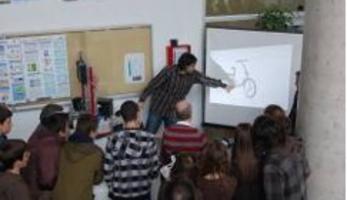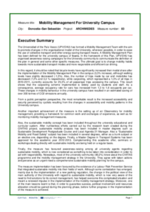Mobility management for the university campus
Basic Information
Mobility solution ID
83
Timeline
- complete
Project
Thematic areas
Summary
Donostia-San Sebastian was willing to reduce private car traffic to the city’s university and get people to opt for sustainable modes instead. For that purpose, a Mobility Management Plan was developed in cooperation with the University of the Basque Country (UPV).
Implementing sustainable mobility
The Mobility Management Plan aimed to cut down on car trips for commuting and for business trips to and from the Campus. The implementation was supported by a Mobility Management team and consisted of awareness raising campaigns and programmes for students and personnel to make collective and energy-saving means of transport more attractive and easier to use.
The main objectives of the measure were to:
- Increase the use of public transport;
- Increase the use of walking and cycling;
- Increase the use of car pooling; and
- Promote eco-driving.
Progress
The Universidad del País Vasco (UPV/EHU) formed a Mobility Management Team with the aim to promote changes in the organisational model of the University, wherever possible, in order to ease the use of collective transport and other energy-saving transport means.
A Mobility Management Plan was defined for the University Campus of Ibaeta (Donostia-San Sebastian), including measures under the following strategic lines:
- Create the adequate structural conditions to guarantee the viability of the actions.
- Information and awareness programs for all the students and staff.
- Active participation in decision making structures and institutional bodies to promote a sustainable change and effectiveness in mobility matters.
- Actions to promote the use of public transport among the university community.
- Bicycle promotion at the campus.
- Pedestrian promotion at the campus.
- Car sharing and car pooling promotion at the campus.
- Inclusion of “sustainable mobility” in every university’s learning processes.
In the framework of this Plan, UPV/EHU organised awareness raising campaigns for the University community to communicate the definition of the plan in general and some of the specific measures with the goal to change the habits towards more sustainable transport modes and towards more responsible and efficient car driving.
Another important achievement of the measure was the setting up of an Observatory for Mobility Management. This provided a framework for common work and exchanges of experience, as well as for monitoring mobility management measures. It was an expression of the political, financial and social will to foster the development of the Plan, including the possibility of extending it further in order to get other transport plans off the ground. Invitations to participate were given to different public institutions and private entities or NGOs with an interest in the subject.
Finally, the sustainable mobility concept was included throughout the University educational and curricular system. Sustainable mobility analysis was included in master degrees such us Sustainable Development Postgraduate Course and Local Agenda 21 Manager. Also a “Sustainable Mobility and Road Safety” subject was included in several degrees, either as a trunk subject or an elective one, depending on the degree. Finally, a Master Degree in Transport Systems was approved for the academic year 2012-2013. Complementing this academic offer, seminars or workshops dealing directly with sustainable mobility are being held on a regular basis.
Outcomes
Bicycle use significantly increased in modal share after the implementation of the Mobility Management Plan at the campus (3.3 percent increase), while walking slightly decreased (-1.3 percent). Also, the number of trips made by car and motorbike decreased (7.2 percent and 3.3 percent respectively), while carpooling, which represented a 1.3 percent of all trips in 2010-2011, accounted for 25.3 percent of all passenger trips accessing the campus after the implementation of the Plan. These results show that the carpooling scheme implemented is widely used by students and staff. As a consequence, the average occupancy rate for cars increased from 1.3 to 1.6 occupants per car.
The changes in mobility behaviour in the University campus resulted in an estimated saving of over 300 tonnes of CO2 emissions annually.
From a public perception perspective, the most remarkable result was the increased accessibility and security perceived by cyclists resulting from the changes in accessibility and mobility patterns at the University campus.
After the implementation of the measure, most of the university community (90.2 percent) knew about the CIVITAS programme and the measure that focuses on the campus. They agreed with the actions taken and perceived a comprehensive sustainable mobility planning for the campus as an urgent need.








